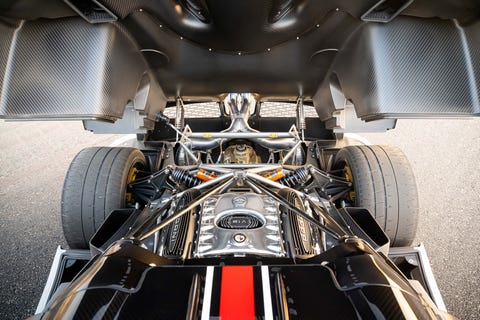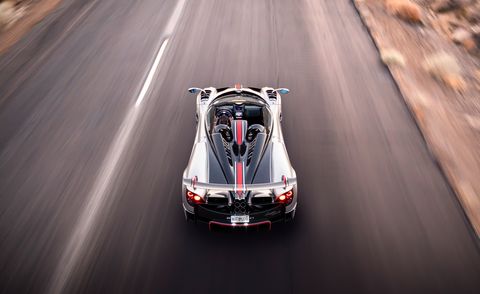From the November 2021 issue of Car and Driver.
Imagine if the Louvre handed over the Mona Lisa for a day. Your own private masterpiece. Take it home, hold it up to your nose for a close look, hang it on your wall. Want to run your fingers over the brushstrokes? Go ahead, no one is looking.
For an auto enthusiast, seeing a $4.0 million Pagani Huayra Roadster BC in the wild is akin to laying eyes on the Mona Lisa. Getting handed the Huayra-shaped key and testing one is like tucking La Gioconda under your arm and making for the exit.
A 3051-pound tribute to the carbon-fiber medium, the Roadster is as much a sculpture as it is a car. It’s the latest in the Huayra Roadster line, which dates to 2017. Only 40 of the targa-top-style BCs will ever exist, so the company is able to labor over each one for a while. Meticulously aligned carbon-fiber panels, titanium fasteners engraved with “Pagani,” leather straps that lock the front and rear clamshells in place—the creator’s marks are all over the thing. There’s artistry in the build quality. Finding imperfection becomes a game. Hey, the carbon weave where the glovebox meets the dashboard is a little off. Oh, wait. It’s not fully closed. Click. Perfect.
We met the BC at a desert proving ground, where it emptied nearby buildings like a bomb threat. Without a velvet rope to protect it, engineers and car lovers mobbed it. Hypercars might be art, but they’re also carnival barkers shouting at everyone in sight to step on up: “Don’t be shy! Come gaze at the otherworldly shape of the $4 million car from Italy.”
It’s hard not to be taken in by the Huayra’s alien-insect aesthetic, the beady little arachnid-eye headlights, the skinny fender-mounted mirrors probing upward like antennae, the chitin-esque gloss of the clear-coated exposed-carbon exoskeleton, the movable flaps in the front, and that tail with its wing and four big exhaust tips.
A steel-subframe latticework bolts to the back of the carbon-fiber passenger tub and supports the control-arm rear suspension, the Mercedes-AMG-sourced 791-hp twin-turbo 6.0-liter V-12, and the seven-speed automated manual. In normal use, the engine is quieter than expected, but if you’re leaning into the accelerator, there is an explosion of sound around 4000 rpm. At wide-open throttle, a merciless 95 decibels will ring your ears. Should you want loudness throughout the rev range, push the exhaust button by the shifter and a speaker behind the driver will amplify the noise to tinnitus-causing levels.
After a briefing on the basic controls and the four steering-wheel-selectable drive modes for the stability-control system, we’re ready to start testing. Launching a 791-hp machine that weighs less than a Porsche 718 Cayman GT4 is like trying to make a Corvette-powered go-kart work. A wall of torque, stacked 774 pound-feet high, arrives at 2000 rpm and remains until 5600. The launch-control program raises the engine speed to 3000 rpm, which is higher than ideal, as the V-12 will overwhelm the rear tires all the way through first and into second gear when the clutch meets the flywheel. Mitigating that time-robbing wheelspin is the key to a quick run.
Testing protocol requires shutting off power-sapping features such as air conditioning, even when it’s 97 degrees outside—in the shade. In the desert sun, the Huayra’s cabin feels like an oven. While we melt like chocolate chips, the car never flinches during 23 acceleration runs. Water and oil temps are as stable as they’d be in an Accord. When we did turn on the A/C, we learned that it doesn’t blow very cold when faced with the Mojave furnace, should you be considering a Huayra for your fleet in Dubai.
Eventually, we get the throttle feathering just right, and the rear tires connect, mostly. But even if you do manage to harness the thrust into forward progress, first gear finds the 6500-rpm redline just below 60 mph. The old-school single-clutch transmission takes its time with that shift, adding precious tenths to the 60-mph time, coming in at 3.3 seconds. That number isn’t so impressive in a two-second world, but the triple-digit acceleration makes you sweat even more than the triple-digit heat.
The quarter falls in 10.4 seconds at 148 mph, and getting to 180 takes a mere 16.5. The metal-faced speedometer reads all the way to 415 km/h (257 mph) in this Euro-spec example. Only the initial launch is tricky; to reach those big speeds, you simply need to hold down the accelerator and keep the steering wheel straight. Shifts aren’t quick or smooth, but the transmission does the job, and Pagani claims it’s 35 percent lighter than a dual-clutch auto. Rough and raw gearchanges are in line with the rest of the brutality the Huayra commits. Yet we couldn’t help fantasizing about what a gated six-speed manual would be like—it might be quicker to accelerate and transform that rawness into something even closer to alive.
With the speedometer needle nearing 200 mph, the car remains stable despite shifting winds and speeds that could put a Boeing in the air, and the steering tracks true and never lightens. The track-focused BC is stripped down and seemingly free of sound deadening; there aren’t even floor mats. At lower speeds, you hear the clack of stones being tossed against the carbon-fiber floor, and at 70, there’s a loud but not punishing 78 decibels of sound. Get past 100 mph, and wind and road noise seems to rise exponentially. Rich guy, bring earplugs. No one wants to shout at you at dinner.
Pirelli’s most exotic and grippy street-legal tires put your inner ear to the test. Tasked with keeping the Huayra on the black, the Trofeo Rs were developed for Pagani and give the Huayra so much grip that the driver needs a moment to adjust. On the skidpad, we measured 1.15 g’s. Reactions to steering inputs are instant but never touchy. A relatively long wheelbase attenuates any nervousness, and the low curb weight allows the Pirellis to quickly recover when you push past their lofty limits. Flaps between the headlights raise and lower to balance the aerodynamics and push the nose down, helping stabilize it. As confidence builds, gentle on-throttle slides of the tail are possible without fear of going down in history as the guy who scratched the Mona Lisa of cars.
Keeping you on the right side of infamy are the carbon-ceramic rotors. Braking distances are in the realm of those of the best cars we’ve ever tested. Erasing 70 mph takes only 139 feet, and we scrub 100 mph in 271 feet. Even after hauling the BC down from 180 mph, the brakes never showed signs of stress. At high speeds, the wing moves itself against the airflow under braking and acts as both a parachute to slow the car and a stabilizer to keep the load transfer balanced and the car steady.
On the road, the pushrod-actuated coil springs and electronically controlled dampers provide a more civil ride than we expected from a car that looks like it should require Nomex. From the driver’s seat, the curved windshield, visible fenders, and exposed carbon fiber certainly set the race-car mood. Tall fender-mounted rearview mirrors are set far enough out for you to see what’s behind the car, which is good because the optional roof duct that directs air over the engine blinds the inside rearview mirror.
Interior design borrows from the retrofuturist school, appearing to have been done by Jules Verne and H.G. Wells. The analog gauges could have come from a Victorian train, and the leather grab handles to close the feathery doors add to the vintage feel. A wooden shift knob—a hat tip to the Porsche 917, Horacio Pagani’s favorite car—tops the shift mechanism’s exposed skeleton. We couldn’t find interior or exterior parts shared with a common car, a surprise from a small-batch carmaker.
Perhaps the best measure of art is what sort of response it creates. Even as a static sculpture, the Huayra stirs something warm and deep inside that makes you fully conscious of your knees—that you’re bipedal and inherently unstable. Drive one and you’re filled with both anxiety and the joy of a V-12 completely unstressed by the car around it. Sound and g-forces flood the nervous system. Yet, despite how hard the Huayra strives for perfection, like any construct of man, it is imperfect. It’s expensive and a gearbox short, but that’s like worrying about Mona Lisa’s lack of eyebrows. Returning the car is a relief. As a work of art, it will probably outlive us all.





![2023 TGR Dakar Team Announced [w/video] 2023 TGR Dakar Team Announced [w/video]](https://img.freepik.com/free-photo/motocross-rider-action-motocross-sport_654080-1649.jpg?ga=GA1.1.2045282162.1728623127&semt=ais_hybrid)
